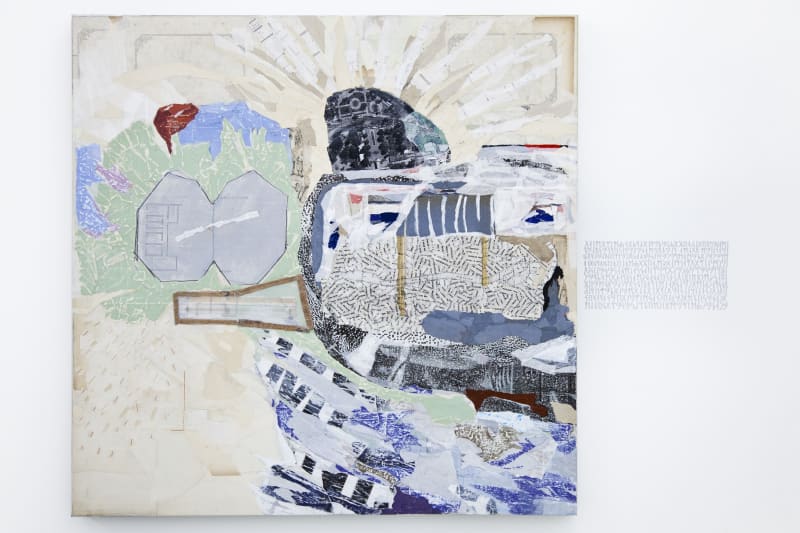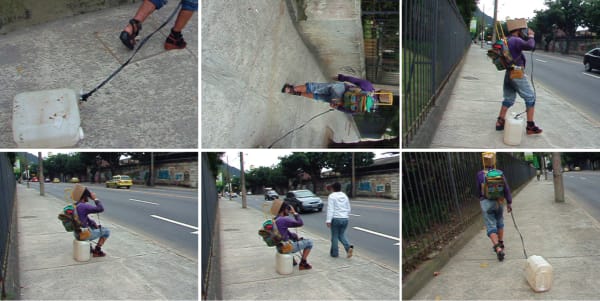Joana Cesar: The Bridge (Where he told me I can’t go)
.
Nearly two decades after the event narrated below, Joana Cesar began to take daily walks along a same specific path: the kilometer-length passage that runs between the Botanical Garden and the Jockey Club in the city of Rio de Janeiro. As the route was jolted and broken up to the point of destruction, what went unnoticed by those driven by the urgency of daily life affected her with all of it: the flow of pedestrians and cyclists on the sidewalk squeezed together and separated by posts here and there; buses and cars coming in the opposite direction with their unavoidable honking; the wind, or lack thereof; the unusual sudden movement of some leaves; the way certain trees grow differently from others; or a patch of river detoured under a discreet bridge, with fish that have been trapped there for who knows how long.
It is as if the sum of these small phenomena in that area were linked to a rift in the urban turbulence, something capable of provoking a rapturous spiritual alliance that suddenly makes us perceive beyond the material structure of things. As in an unstable time, where suspense lives inside each part, at that moment it was possible to feel the concentrated energy between the park's railing and the large wall across the street.
Each visit to the area meant going to meet the happening, the event.
..
A person crossing the street catches the attention of eyes enclosed by car windows but in every way committed to the phenomena outside. The figure, who wore a hat made of a cardboard box, a purple sweatshirt, jeans wet with urine rolled halfway up his shins, a different platform sandal on each foot-and a filthy backpack with children's motifs on it, moves with rhythmic footsteps, carrying with him a bunch of gadgets and trappings. Then he steps in front of the cars, that are forced to brake suddenly. As the noise of the gears dies down, comes the sound of an empty plastic gallon can dragged along the asphalt by a rope tied to the man's wrist.
The observer was Joana, who jumps out of the car and follows him. If he sees her, he doesn't object to her presence and keeps moving. She takes out a camera to record his actions. His identity is discovered: José Carlos Telefônica Mundial. At a certain moment, he stops. He lifts one foot off the ground, then the other, and finally the first one again. He pulls some contraption from his waist that he puts next to his face. In the middle of the sidewalk, he turns toward the asphalt and uses the gallon can as a stool. It's a mirror that he holds close to his eyes. At that point he stops walking. That's when he starts to see the world and face others. The mirror is his device for contemplation. The mirror is his opening.
...
For more than a year, Joana's walks through that passage became a destination. She needed to experience the itinerary countless times. She needed to probe so much provocation more insistently. She needed to realize how much is hidden and how much revealed at any given moment, at any crossing. She needed to go back and forth. She needed to walk with the awareness of many angles and senses. She needed to draw maps of the place with a particular cartography, to photograph its mundane absurdities with her cell phone. She needed to give names to things that didn't yet have names. She needed to feel and understand more about that dark and sensual atmosphere that surfaced whenever her body moved through that space.
....
Combing through her digital files, the artist finds the photos and videos she had taken of the young man on the street about 17 years ago. In the next moment, she realizes that the meeting happened exactly in the part of that passageway that was now the object that so mobilized both her affections and efforts.
The sender found-fully-in herself, sometime later, a recipient.
.....
Joana is now bringing works together-exposed as fragments of a diary-which record, comment, and also codify the core of this encounter. A greater encounter broken up into many parts, phases and folds. For in it is the encounter of the physicality that composes the itinerary with the immaterial esoteric that can assault us without warning when we are there; the encounter with the man who walked down the street that day in the year 2000; the encounter with the very records that the artist had made and kept for so many years; The encounter with the strangeness that exists in any detail; the encounter between document and fiction; and finally, the encounter of her subjectivity with the spokesperson who now sees herself before a part of her most intimate repertoire.
These are collages, photographs and videos that exist through objective channels and others that are less clear. But in everything, the autonomy of the artist is marked by her wanderings and her intense as possible relations with her imagination, and the extravagant fantasy that pervades the street. They are actions that are aware of the moment in which the happening, the event, opens up for those who want to perceive it.
......
If the bridge connects, it inevitably is also placed as a measure of distance. Joana travels over bridges-material, metaphorical or mental-with obstinacy. In this process of adventure and repetition, the artist seems to want to dissect everything that concerns her, as much as possible. But not so that you can fully understand every aspect of the journey, but so that you can glimpse the terrible-and relentless-dimension of detachment. The gap between departure and arrival, between occurrence and perception, between code and deciphering.
Germano Dushá










